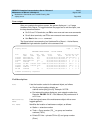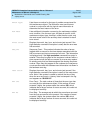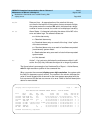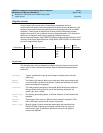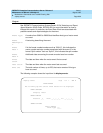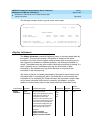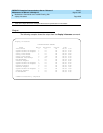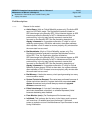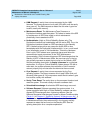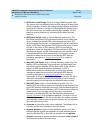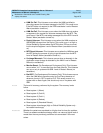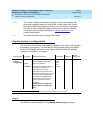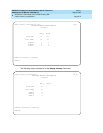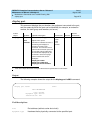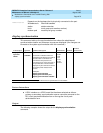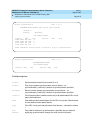
DEFINITY Enterprise Communications Server Release 6
Maintenance for R6vs/si
555-230-127
Issue 1
August 1997
Maintenance Commands and Trouble-Clearing Aids
Page 8-68display initcauses
8
■ LMM Request: A sanity time-out was requested by the LMM
firmware. The three processor circuit pack LEDs blink until the sanity
timer goes off. The LMM requests a restart like this when it gets into
trouble, usually with memory.
■ Maintenance Reset: The Maintenance/Tape Processor or
Duplication Interface reset the system. This refers to resets of the SPE
by maintenance in SPE Down mode in which maintenance
periodically tries to awaken the SPE.
■ No Handshake: (High or Critical Reliability System only) The
Duplication Interface lost handshaking with the active SPE. Thus, the
Duplication Interface initiated an SPE-interchange to the Standby
SPE. A defective tape drive may cause the Active SPE to miss
handshakes with the Duplication Interface which, in turn, could result
in an initialization cause of “No Handshake.” Check the Hardware
Error Log for TAPE-related error types and alarms and follow the
recommended repair procedures in the TAPE Maintenance
documentation. If this initcause triggers an SPE interchange when the
Standby is NOT in Maintenance mode, the previous entry in the log
may actually represent a restart that occurred on the Standby SPE.
See the preceding description of display initcauses for a complete
explanation. If a High or Critical Reliability System does a PEI with a
warm start, the system software often requests a Cold 2 restart to
recover properly only minutes after the warm start has occurred.
■ Oryx Request: A sanity time-out was requested by the Oryx
operating system. The three processor circuit pack LEDs blink until
the sanity timer goes off. Oryx requests a restart like this when it gets
into trouble, usually with software.
■ Sanity Timer Reset: The sanity timer on the processor timed out and
reset the system. This event usually indicates a software fault.
■ Scheduled Interchange: A scheduled SPE-interchange occurred.
■ Software Request: Software requested the system restart. In a
system equipped with High or Critical Reliability, software can also
request SPE-interchanges when it detects problems. See the
Software Requested Interchanges Caused by Alarm Conditions table
(Table 6-1
) in Chapter 6, ‘‘Reliability Systems: A Maintenance Aid’’. If
this initcause triggers an SPE interchange when the Standby is NOT
in Maintenance mode, the previous entry in the log may actually
represent a restart that occurred on the Standby SPE. See the
opening description for a complete explanation.



